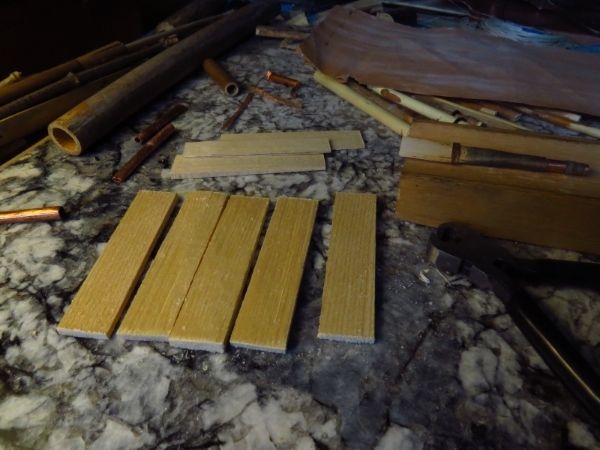Thanks Larry for the update on your spruce reeds, it is encouraging to hear
about your success, especially the comparison with cane reeds.
I wonder what the best spacing is for growth rings on a slip...
With the spruce I used (came from packing crates - some looks a lot like
the stuff in Lorenzo's pic, some has a slight pinkish or brownish tinge
and the growth rings are not as even - some wider some narrower)
I found that earlywood (the pale softer stuff between the darker rings)
much wider than 1mm tended to flex very easily as it got thinner at the edges
of the slip.
With pressure it produced a recurved shape gap at the lips
(like Mick Jagger's lips, rather than a cat's eye shape).
The first few slips I cut with the closer spaced rings at the centreline of
the slip. These produced this effect very easily.
The next few I cut with the widest spaced rings along the centreline, the
narrower along the edges. These were not so bad.
I was initially dismayed by this as I thought these reeds would have an
unstable back d; the usual result of weak corners on a reed.
I looked at those slips again today, all are stiffer than when I cut & sanded them
about 6 months ago, and much more evenly so. I can only imagine they have
dried out somewhat, even though the wood was under cover for years before
I cut them.
I am more confident that I might get a working reed from them than
I was yesterday.
I would recommend with spruce using pieces with a ring spacing
of around 1.25mm or less with as even ring spacing as possible.
Leaving them some time to settle before final sanding and tieing
might help. Though I can't help wondering if the extra flexibility of a
freshly cut piece would help in avoiding splitting when I tie the slips
to the staple.
The spruce I used sanded noticeably quicker than cane.
I cut adjacent pieces ~60mm long ~3mm thick, then trimmed them with a
block plane with a SHARP carbon steel blade to an even thickness of 2.5-2.7mm.
I then glued the pieces together with a drop of superglue on the
centreline near each end so the growth rings matched.
I then trimmed them to width (0.5-1mm oversize) along the grain with a
sharp hobby knife, then cleaned up the edges with the block plane.
I then sanded the outside curve on each side in a concave sanding block
(I used 25mm ID for narrow bore, 28mm ID for concert pitch).
I checked for thickness with a digital caliper, eyeballed for eveness.
I then split the two pieces at the glue joint with the hobby knife,
and sanded the inside curve in each piece on a sanding cylinder.
Again I checked for thickness with a digital caliper, eyeballed for eveness.
The lips ends need more care using this method, not to taper too much near
the inside of the lips.
This is as far as I have got to date.
I will raise the grain using the method I described above,
cut the tails as usual, raise the grain again, final sand, then tie.
After that will come the real tricky stuff.
